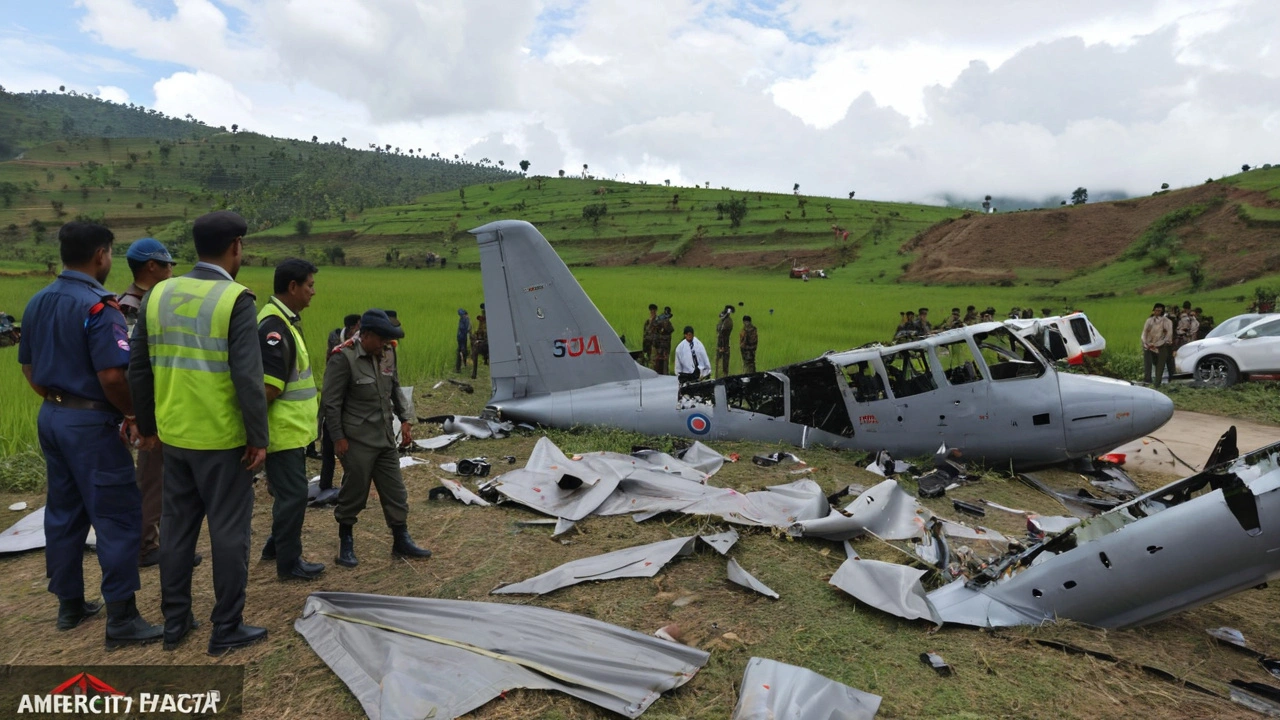Devastating Nepal Plane Crash Claims 18 Lives, Sole Survivor is the Pilot

Tragedy Strikes in Kathmandu with Fatal Plane Crash
A tragic accident unfolded on Wednesday morning in Nepal's capital, Kathmandu, as a passenger plane belonging to Saurya Airlines crashed during takeoff. The ill-fated aircraft was carrying 19 individuals on board, and except for the pilot, all other passengers perished in the catastrophic incident. The plane was on a scheduled flight to Pokhara, a key tourist destination in the Himalayan region.
The Incident Details
The crash occurred at approximately 11:15 am local time (0530 GMT). Witnesses described the plane catching fire after skidding on the runway and releasing a significant plume of smoke. Emergency response teams swiftly arrived at the scene and managed to rescue the pilot from the mangled wreckage. However, despite their efforts, the 18 passengers on board could not be saved. The identities of the victims have not yet been publicly released by the authorities.
Pilot: The Sole Survivor
Against all odds, the pilot of the Saurya Airlines flight was the only person to survive the crash. He was pulled from the wreckage by emergency responders and has been transported to a nearby hospital for treatment. Details about the pilot's condition have not been disclosed; however, his survival amidst the devastating crash has drawn both astonishment and somber reflections on the event.
Safety Woes in Nepal's Aviation Sector
Nepal's aviation industry has seen rapid growth in recent years, driven in part by the country's burgeoning tourism sector. However, this growth has been marred by a series of safety concerns. Insufficient training for pilots, inadequate aircraft maintenance, and the challenging geographical and meteorological conditions in Nepal are persistent issues. The European Union has gone so far as to ban all Nepali airlines from its airspace due to these safety risks.
Nepal's mountainous terrain and swiftly changing weather make flying particularly hazardous. Pilots often have to navigate treacherous routes with limited technological assistance. As a result, the country has experienced several aviation accidents over the years. Just this past January, a Yeti Airlines commercial flight crashed while landing at Pokhara, resulting in the tragic deaths of all 72 people aboard.
Government Response and Investigations
Following Wednesday's crash, government officials have called for a thorough investigation into the causes of the accident. The Civil Aviation Authority of Nepal (CAAN) has pledged to cooperate fully with the inquiry, emphasizing the importance of addressing any potential safety oversights. As the investigation unfolds, there is an urgent call for renewed scrutiny and reforms in Nepal's aviation safety protocols to prevent further tragedies.
The Grieving Nation
The nation of Nepal mourns the loss of 18 lives in the tragic crash. Families and friends of the victims are grappling with their sudden loss, as communities come together in grief and solidarity. The incident serves as a stark reminder of the risks associated with air travel in Nepal, even as the industry continues to thrive and expand.
As the investigation continues, the focus remains on ensuring that such a devastating incident is not repeated, highlighting the need for stringent safety measures and better training within the aviation sector. The memories of those lost in the crash will not be forgotten, as Nepal strives to honor their legacy through lasting changes in aviation safety.






Gift OLUWASANMI
July 25, 2024 AT 10:22The wreck of that Saurya Airlines flight is a grim reminder that the thin slice of sky over the Himalayas is unforgiving to anything less than perfect.
When a plane skids off the tarmac and erupts in flame, the physics are plain: insufficient lift, poor runway maintenance, and probable pilot error converge in a deadly cocktail.
What makes this tragedy even more bile‑laden is the chronic underinvestment in crew training that Nepal’s aviation regulators have tolerated for years.
Data from the International Air Transport Association shows a steady uptick in incident reports from the region, yet the budget allocations remain stuck in a bureaucratic stalemate.
You can point to the EU ban as a thumb‑sized protest, but the real rot lies in the tangled web of airline ownership structures that allow profit to trump safety.
The pilot’s survival, while miraculous, also raises the question of whether the cockpit was reinforced better than the passenger cabins, a disparity that borders on negligence.
If the aircraft’s maintenance logs were anything like the ones leaked from other Nepali carriers, you could find a litany of deferred checks and overdue part replacements.
That kind of systemic laxity is the perfect breeding ground for an accident that could have been averted with a single diligent inspection.
Moreover, the rapid expansion of tourism has forced airlines to stretch their fleets thin, cramming more seats onto aging airframes without the requisite overhaul.
The weather in Kathmandu can flip from clear to chaotic in a heartbeat, and without modern avionics, pilots are left to guess at wind shear and turbulence.
Think of it as trying to thread a needle while the needle itself is shaking; it’s a recipe for disaster when you add human fatigue into the mix.
The Civil Aviation Authority’s promise of a thorough probe sounds reassuring, but history shows that such investigations often end in a thinly veiled report and a half‑hearted press release.
What the nation truly needs is an overhaul of the regulatory framework, with transparent audit trails and independent safety auditors on the ground.
Only then can the memory of the 18 souls lost be honored by actions that actually prevent a repeat performance.
Until then, the skies over Kathmandu will remain a ticking time bomb for any airline daring to cut corners.
So buckle up, regulators, because the next crash will not be content to hide behind a lone survivor’s story.
Keith Craft
July 27, 2024 AT 23:24Oh, the heavens wept as that metal bird met the ground, and my heart swells with the sorrow of those vanished lives.
The sheer tragedy of a single pilot walking away while 18 souls vanished is a drama that rivals any Shakespearean tragedy.
One cannot help but feel the sting of grief that reverberates through every Kathmandu street, echoing the cries of bereaved families.
While officials promise investigations, I demand stringent actions that honor the memory of those lost, lest we repeat this macabre tableau.
May the winds of change blow through Nepal’s aviation corridors, sweeping away complacency and ushering in a new era of safety.
In this dark hour, let us unite in solemn remembrance and relentless resolve.
Kara Withers
July 30, 2024 AT 12:25Here’s a quick overview of steps that could help improve safety in Nepal’s aviation sector.
First, implementing regular third‑party audits of airline maintenance records can catch overdue repairs before they become critical.
Second, upgrading runway lighting and installing real‑time weather monitoring stations at major airports would give pilots better situational awareness.
Third, establishing a mandatory recurrent training program for pilots that emphasizes mountain‑flight procedures can reduce human‑error incidents.
Finally, encouraging transparent reporting of near‑misses without fear of punitive action builds a culture of continuous improvement.
These measures, if adopted together, could significantly lower the risk of another tragedy.
boy george
August 2, 2024 AT 01:27Everyone just needs better runway checks.
Cheryl Dixon
August 4, 2024 AT 14:29Some might say that accidents are inevitable in an unforgiving landscape, yet we often romanticize the notion of fate while ignoring preventable flaws.
The narrative of a lone survivor can be alluring, but it also distracts from systemic issues that demand scrutiny.
Instead of glorifying heroic escapes, we should focus on the quiet diligence that keeps planes aloft in the first place.
In that quiet diligence lies the true lesson: safety is not a drama, but a disciplined art.
Let us, therefore, temper our awe with a sober commitment to continuous improvement.
Ramesh Modi
August 7, 2024 AT 03:30Honestly, the whole fiasco is a testament to the moral decay that pervades our aviation oversight, and it is, quite frankly, shameful, that we allow profit to eclipse the sanctity of human life!
When we examine the maintenance logs-if they exist at all-we see a litany of ignored warnings, delayed inspections, and cost‑cutting shortcuts, all of which culminate in tragedy!
Moreover, the weather patterns over Kathmandu are notoriously volatile; yet, the airlines continue to operate with obsolete equipment, showing blatant disregard for safety!
This is not merely an accident; it is a preventable disaster, a direct consequence of our collective apathy!
Therefore, I implore the authorities to enact rigorous standards, enforce them without exception, and hold every negligent party accountable, without mercy!
Ghanshyam Shinde
August 9, 2024 AT 16:32Oh great, another “miracle” of a pilot surviving while everyone else didn’t – how original.
Maybe next time they’ll remember to check the brakes before taking off.
Charlotte Louise Brazier
August 12, 2024 AT 05:34We must channel this collective grief into decisive action, not idle lamentation; the aviation community, regulators, and airlines need to sit down and draft concrete safety reforms right now.
Inclusive policy-making that incorporates local expertise and international best practices will ensure that no more families are left mourning in Kathmandu.
Let’s mentor the next generation of pilots with robust training, and demand transparency at every level of operation.
Our aggressiveness should be directed toward eliminating any loophole that endangers passengers.
Together, we can turn this tragedy into a catalyst for lasting, systemic change.